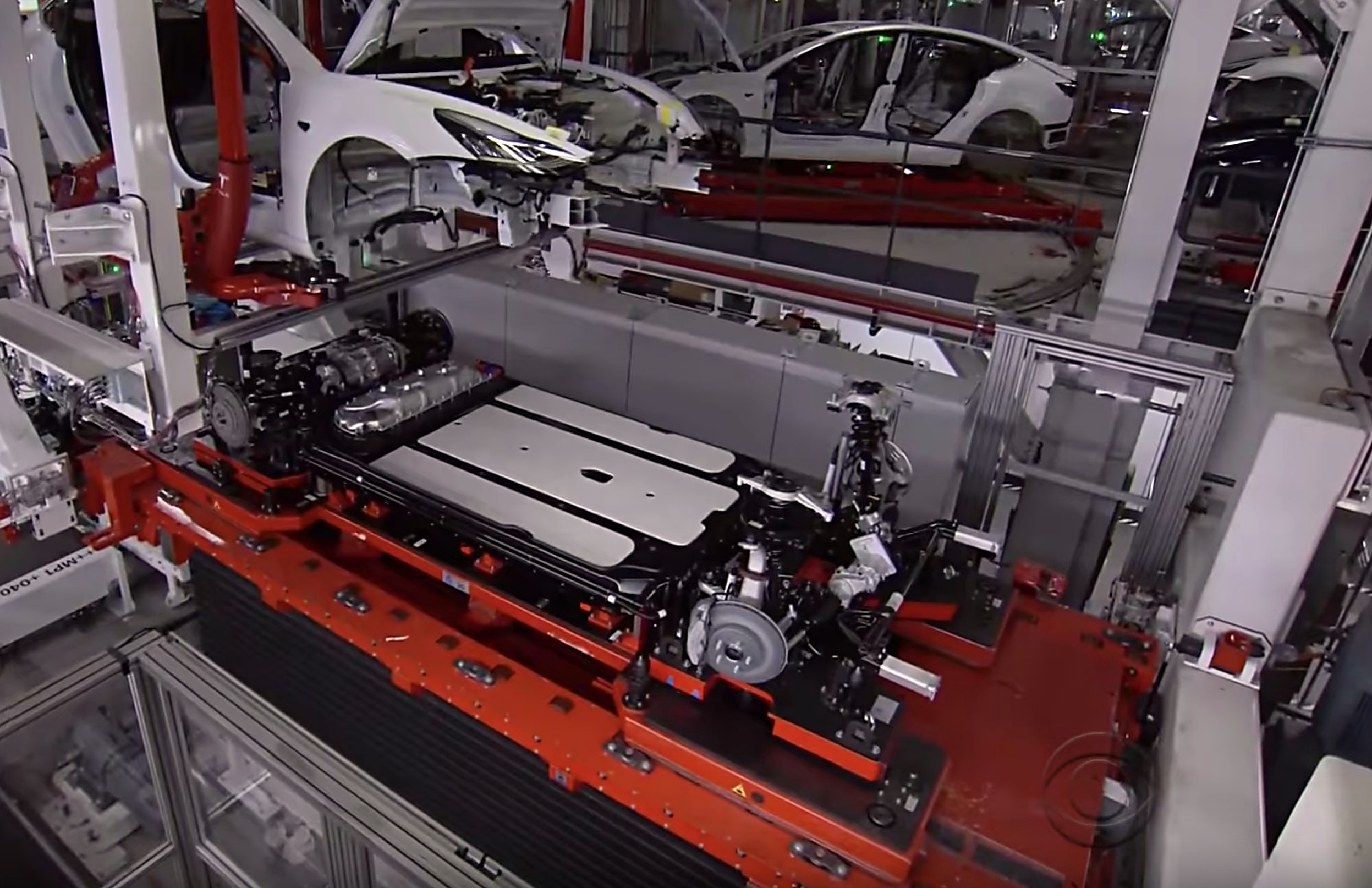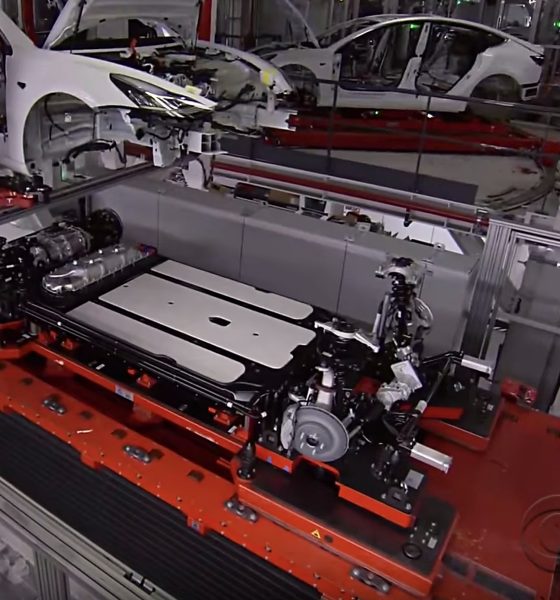

News
Tesla’s approach to battery technology keeps it ahead in the EV industry
Tesla’s dominance in the growing electric vehicle (EV) industry is largely attributed to its unique approach to its battery technology. The engineering behind the all-electric car maker’s cylindrical cells speaks for itself in terms of the performance and range achieved, but in a recent interview with a battery technology researcher, a few things detailed about Tesla’s batteries stood out in particular.
Ravindra Kempaiah is a Ph.D. scholar at the University of Illinois Chicago focusing on advanced battery materials for his thesis. In his interview with Tesla owner and host of All Things EV, Sean Mitchell, Kempaiah explained lithium-ion technology in EVs and the primary issues faced in their development. Overall, the biggest challenge is balancing the three main components in battery production: energy density, cost, and cycle life. Increasing one area will significantly impact the other, and the ideal equation is always being sought after. For example, if you increase energy density for higher range and lower cost, the cycle life takes a major hit. If you increase density and life cycle, the battery alone can cost as much as $100k, as described by Kempaiah.
“We always want more range. We always want higher cycle life. We want our batteries to last 15-20 years and the car to go 500 miles, but this is a problem every battery scientist has faced for the last 30 years,” Kempaiah commented in the interview.
Tesla deals with the same balancing act as other battery-electric car makers; however, there are key factors which seem to have kept the company ahead in the industry.

First, Tesla’s choice of cylindrical cells sets it apart from every other electric vehicle on the market. This provides several advantages that drive performance, flexibility, and cost control. Notably, Rivian is also using cylindrical cells, although their vehicles are not yet under production.
Out of the three types of cells available (cylindrical, prismatic, and pouch cells), cylindrical is the most cost-effective to produce. Namely, the cost per kWh is lower in cylindrical cells versus other types. The metallic jacket around the 18650 and 2170 cylindrical cells used in the Tesla Model S/X and Model 3, respectively, acts as scaffolding and provides structural rigidity to the battery. Additionally, in high powered situations, current draw and distribution of power is over the entirety of the battery pack instead of concentrated in a certain section, according to Kempaiah.
Second, Tesla uses a liquid-cooled thermal management system to manage battery temperatures whereas other automakers take a more economical air cooling approach. By adjusting the temperature of the battery pack, Tesla is able to ensure that cells are operating in their most efficient and optimal states, thereby maximizing battery longevity as well as performance. While reducing cost is an important factor in accelerating the growth of the electric vehicle market, Tesla’s investment in thermal management technology provides an upside for owners who may be looking for longevity and long-term affordability of their cars.

Third, Tesla has actively sought to limit the amount of cobalt it uses in its batteries and already uses less of the element than other companies in the Model 3 batteries. The scarcity of cobalt and its mining sources have subjected it to socioeconomic situations that are more than problematic in the United States, i.e., child labor and similar abuses are widespread in its sourcing. With this in mind, Tesla has been working on the question, “Is cobalt really needed?”
Cobalt is used as a cathode in battery technology, and out of all cathode materials available, it has the highest cost both fiscally and politically. Current consensus on battery technology says that without cobalt, the structural integrity and cycle life in batteries is compromised, as described in the interview. However, some recent scientific literature was cited by Kempaiah that indicated higher nickel content limited the impact of cobalt on batteries, possibly removing the need to use it at all. Nickel is more widely available across the globe, which keeps its cost down and mitigates the socioeconomic impacts often associated with resource mining operations. Overall, the discussion between Mitchell and Kempaiah indicated that Tesla can probably go cobalt-free soon, making it less vulnerable to the cobalt industry.
Finally, Tesla takes great care to educate its customers about proper battery maintenance, especially with regard to the negative impact of bad charging habits. Specifically, keeping an electric car battery charged at 100% for long periods degrades the battery very quickly, while keeping charging states within an optimal range will give it a long life. Tesla makes it a point to communicate to customers the importance of battery health on their overall ownership experience and value of their purchase.
When asked for his opinion by Mitchell, Kempaiah attributed the lack of education by other brands as a disconnect between engineering teams and marketing teams. While battery “best practices” are provided to EV customers by all manufacturers, the importance of communicating the true impact of bad charging habits may not be emphasized enough to be included as prominently as it should.
In summary, Tesla is constantly developing the technology in its vehicles, and its particular attention to its batteries looks to have given the company a significant advantage over its competitors. Perhaps other automakers will take a few tips from Tesla in the future, even if it’s as limited as improving communications with customers.
Watch Sean Mitchell’s full interview with Ravindra Kempaiah below:

News
Tesla FSD fleet is nearing 7 billion total miles, including 2.5 billion city miles
As can be seen on Tesla’s official FSD webpage, vehicles equipped with the system have now navigated over 6.99 billion miles.

Tesla’s Full Self-Driving (Supervised) fleet is closing in on almost 7 billion total miles driven, as per data posted by the company on its official FSD webpage.
These figures hint at the massive scale of data fueling Tesla’s rapid FSD improvements, which have been quite notable as of late.
FSD mileage milestones
As can be seen on Tesla’s official FSD webpage, vehicles equipped with the system have now navigated over 6.99 billion miles. Tesla owner and avid FSD tester Whole Mars Catalog also shared a screenshot indicating that from the nearly 7 billion miles traveled by the FSD fleet, more than 2.5 billion miles were driven inside cities.
City miles are particularly valuable for complex urban scenarios like unprotected turns, pedestrian interactions, and traffic lights. This is also the difference-maker for FSD, as only complex solutions, such as Waymo’s self-driving taxis, operate similarly on inner-city streets. And even then, incidents such as the San Francisco blackouts have proven challenging for sensor-rich vehicles like Waymos.
Tesla’s data edge
Tesla has a number of advantages in the autonomous vehicle sector, one of which is the size of its fleet and the number of vehicles training FSD on real-world roads. Tesla’s nearly 7 billion FSD miles then allow the company to roll out updates that make its vehicles behave like they are being driven by experienced drivers, even if they are operating on their own.
So notable are Tesla’s improvements to FSD that NVIDIA Director of Robotics Jim Fan, after experiencing FSD v14, noted that the system is the first AI that passes what he described as a “Physical Turing Test.”
“Despite knowing exactly how robot learning works, I still find it magical watching the steering wheel turn by itself. First it feels surreal, next it becomes routine. Then, like the smartphone, taking it away actively hurts. This is how humanity gets rewired and glued to god-like technologies,” Fan wrote in a post on X.
News
Tesla starts showing how FSD will change lives in Europe
Local officials tested the system on narrow country roads and were impressed by FSD’s smooth, human-like driving, with some calling the service a game-changer for everyday life in areas that are far from urban centers.

Tesla has launched Europe’s first public shuttle service using Full Self-Driving (Supervised) in the rural Eifelkreis Bitburg-Prüm region of Germany, demonstrating how the technology can restore independence and mobility for people who struggle with limited transport options.
Local officials tested the system on narrow country roads and were impressed by FSD’s smooth, human-like driving, with some calling the service a game-changer for everyday life in areas that are far from urban centers.
Officials see real impact on rural residents
Arzfeld Mayor Johannes Kuhl and District Administrator Andreas Kruppert personally tested the Tesla shuttle service. This allowed them to see just how well FSD navigated winding lanes and rural roads confidently. Kruppert said, “Autonomous driving sounds like science fiction to many, but we simply see here that it works totally well in rural regions too.” Kuhl, for his part, also noted that FSD “feels like a very experienced driver.”
The pilot complements the area’s “Citizen Bus” program, which provides on-demand rides for elderly residents who can no longer drive themselves. Tesla Europe shared a video of a demonstration of the service, highlighting how FSD gives people their freedom back, even in places where public transport is not as prevalent.
What the Ministry for Economic Affairs and Transport says
Rhineland-Palatinate’s Minister Daniela Schmitt supported the project, praising the collaboration that made this “first of its kind in Europe” possible. As per the ministry, the rural rollout for the service shows FSD’s potential beyond major cities, and it delivers tangible benefits like grocery runs, doctor visits, and social connections for isolated residents.
“Reliable and flexible mobility is especially vital in rural areas. With the launch of a shuttle service using self-driving vehicles (FSD supervised) by Tesla in the Eifelkreis Bitburg-Prüm, an innovative pilot project is now getting underway that complements local community bus services. It is the first project of its kind in Europe.
“The result is a real gain for rural mobility: greater accessibility, more flexibility and tangible benefits for everyday life. A strong signal for innovation, cooperation and future-oriented mobility beyond urban centers,” the ministry wrote in a LinkedIn post.
News
Tesla China quietly posts Robotaxi-related job listing
Tesla China is currently seeking a Low Voltage Electrical Engineer to work on circuit board design for the company’s autonomous vehicles.

Tesla has posted a new job listing in Shanghai explicitly tied to its Robotaxi program, fueling speculation that the company is preparing to launch its dedicated autonomous ride-hailing service in China.
As noted in the listing, Tesla China is currently seeking a Low Voltage Electrical Engineer to work on circuit board design for the company’s autonomous vehicles.
Robotaxi-specific role
The listing, which was shared on social media platform X by industry watcher @tslaming, suggested that Tesla China is looking to fill the role urgently. The job listing itself specifically mentions that the person hired for the role will be working on the Low Voltage Hardware team, which would design the circuit boards that would serve as the nervous system of the Robotaxi.
Key tasks for the role, as indicated in the job listing, include collaboration with PCB layout, firmware, mechanical, program management, and validation teams, among other responsibilities. The role is based in Shanghai.
China Robotaxi launch
China represents a massive potential market for robotaxis, with its dense urban centers and supportive policies in select cities. Tesla has limited permission to roll out FSD in the country, though despite this, its vehicles have been hailed as among the best in the market when it comes to autonomous features. So far, at least, it appears that China supports Tesla’s FSD and Robotaxi rollout.
This was hinted at in November, when Tesla brought the Cybercab to the 8th China International Import Expo (CIIE) in Shanghai, marking the first time that the autonomous two-seater was brought to the Asia-Pacific region. The vehicle, despite not having a release date in China, received a significant amount of interest among the event’s attendees.








